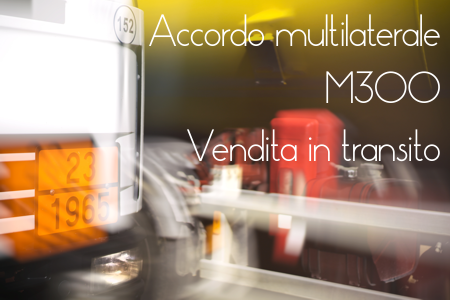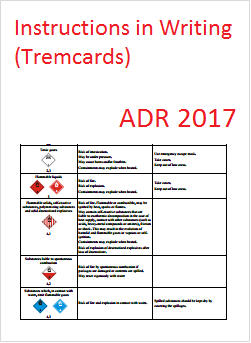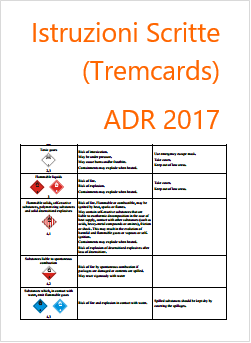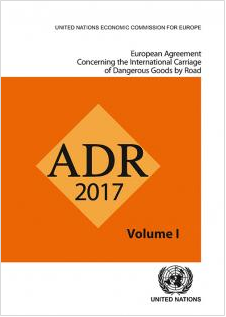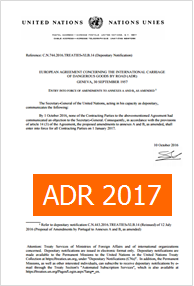Safety ADR / Dangerous Goods App
Safety ADR© is an app for the transport of ADR dangerous goods which allows you to:
– view the entire Table A chap. 3.2 ADR per ONU/denominazione/classe/altro* (Italiano, Inglese);
– fill in the "Subject Report" for each ADR subject with the "Safety" parameter (1) (Italiano, Inglese);
– fill in the "Tremcards P" for each ADR subject.0” (2) (Italiano, Inglese);
– consult the Written Instructions according to the ADR (Inglese, Italiano, Francese, Russo, Danese, Lettone, Norvegese, Svedese, Tedesco, Ungherese, Romeno, Portoghese, Ceco, Spagnolo, Turco, Sloveno, Slovacco, Estone, Neerlandese (Belgio), Neerlandese (Paesi Bassi), Polacco, Finlandese, Lituano, Bulgaro, Greco, Serbo);
– have real-time news displayed directly on Home;
– consult the ADR agreement (Inglese, Francese);
– consult the ADR labels, le classi, i Kemler (Italiano, Inglese).
Accordo Multilaterale ADR M300: Siglato Italia
(*) Attenzione traduzione non ufficiale, in verifica.Le materie interessate:
UN 0333
UN 0334
UN 0335
UN 0336
UN 0337
UN 1001
UN 1002
UN 1006
UN 1013
UN 1046
UN 1049
UN 1066
UN 1072
UN 1073
UN 1202
UN 1951
UN 1954
UN 1956
UN 1963
UN 1965
UN 1972
UN 1977
UN 2187
UN 3156
UN 3157
UN 3158
UN 3161
UN 3163
________
MULTILATERAL AGREEMENT M300
Transport document in sale delivery operations (DELIVERY SALE) according to section 1.5.1 of ADR concerning the transport document in sale delivery operations.
1. By derogation from the provisions of 5.4.1.1.1, sub-paragraph h), of ADR, the name and address of the consignee(s) in the transport document may be replaced by the words «DELIVERY SALE» when the following substances are transported to multiple consignees that cannot be fully identified before the transport starts:
UN 0333
UN 0334
UN 0335
UN 0336
UN 0337
UN 1001
UN 1002
UN 1006
UN 1013
UN 1046
UN 1049
UN 1066
UN 1072
UN 1073
UN 1202
UN 1951
UN 1954
UN 1956
UN 1963
UN 1965
UN 1972
UN 1977
UN 2187
UN 3156
UN 3157
UN 3158
UN 3161
UN 3163
2. In addition to the information prescribed, the consignor shall enter the following in the transport document: “Carriage agreed under the terms of section 1.5.1 of ADR (M300)”.
3. This agreement shall be valid until 12 May 2021 for the carriage on the territories of those ADR Contracting Parties signatory to this agreement. If it is revoked before then by one of the signatories, it shall remain valid until the above mentioned date only for carriage on the territories of those ADR Contracting Parties signatory to this agreement which have not revoked it.
Lisbon, 12 May 2016
The competent authority for ADR of Portugal
José Alberto Franco
Signe:
Portugal – 29/06/2016
Spain – 11/07/2016
Italy – 22/05/2017
Available Safety ADR updated ADR 2017
Safety ADR updated ADR 2017
Available Safety ADR, update ad ADR 2017.
Available in the Apple Store, the “Safety ADR” app with database update to ADR 2017 and other features that can be very useful in mobility.
Changelog:
– 0002595: ADR 2017: UN Materials Update
– 0002598: ADR 2017: New label “9A – Class 9A battery or lithium batteries” and “Lithium batteries battery symbol”
– 0002550: ADR 2017: Text Correction of the “Safety Parameter” in the “Material Report”
– 0002038: ADR 2017: Report Update “Written Instructions”
– 0001429: Copy, Print, and Share Label Function
– 0002599: Link UNECE
– 0002594: Adaptation to new devices
– 0001538: 64 bit support
– 0002600: Support iOS Standard Sharing Panel for Report PDFs
– 0002537: Change address address Certifico s.r.l. And year
Info App:
Price: free
Purchase ADR 2017 database: € 23,99 (Purchase in app)
Category: Reference
Published: 15/05/2017
Version: 1.0.2
Size: 16.9 MB
Languages: Italian, English
Developer: I certify S.r.l.
© 2000-2017 I certify S.r.l.
For all the details:
Apple Store
Disponibile Safety ADR: aggiornata ADR 2017
Safety ADR: Update ADR 2017
Disponibile Safety ADR, aggiornata ad ADR 2017.
Disponibile in Apple Store l’app “Safety ADR” con l’aggiornamento del database ad ADR 2017 ed altre funzionalità che possono essere molto utili in mobilità.
Changelog:
– 0002595: ADR 2017: Aggiornamento materie ONU
– 0002598: ADR 2017: Nuova etichetta “9A – Classe 9A pile o batterie al litio” e “simbolo pile-batterie litio”
– 0002550: ADR 2017: Correzione testo del “Safety Parameter” nel “Report Materia”
– 0002038: ADR 2017: Aggiornamento del report “Istruzioni Scritte”
– 0001429: Funzione di copia, stampa e condivisione etichette
– 0002599: Link UNECE
– 0002594: Adeguamenti ai nuovi dispositivi
– 0001538: Supporto 64 bit
– 0002600: Supporto al pannello standard di condivisione di iOS per i PDF dei report
– 0002537: Cambiamento indirizzo sede Certifico s.r.l. e anno
Info App:
Prezzo: gratuito
Acquisto database ADR 2017: € 23,99 (Acquisto in app)
Categoria: Riferimento
Pubblicato: 15/05/2017
Versione: 1.0.2
Dimensioni: 16.9 MB
Lingue: Italiano, Inglese
Sviluppatore: I certify S.r.l.
© 2000-2017 I certify S.r.l.
Per tutti i dettagli :
Apple Store
Instructions in Writing (Tremcards) ADR 2017
Instructions in Writing (Tremcards) ADR 2017
The official models of Instructions in Writing (Tremcards) ADR 2017
Recall that with the ADR 2015 tremcards have changed.
Annex Article tremcards the release date, we will update the models attached to the official release on the UNECE website.
Update 12.05.2017
Istruzioni Scritte (Tremcards) ADR 2017
Istruzioni Scritte (Tremcards) ADR 2017
I modelli ufficiali delle Istruzioni Scritte (Tremcards) ADR 2017
Ricordiamo che con l’ADR 2015 le Tremcards sono state modificate.
Allegato all’articolo le Tremcards rilasciate ad oggi, aggiorneremo i Modelli allegati al rilascio ufficiale sul sito dell’UNECE.
Update 12.05.2017
https://www.certifico.com/merci-pericolose/adr/tremcards-adr
ADR 2017: file
ADR 2017
The European Agreement concerning the International Carriage of Dangerous Goods by Road (ADR 2017)
Update: 04.01.2017
General
The European Agreement concerning the International Carriage of Dangerous Goods by Road (ADR) was done at Geneva on 30 September 1957 under the auspices of the United Nations Economic Commission for Europe, and it entered into force on 29 January 1968. The Agreement itself was amended by the Protocol amending article 14 (3) done at New York on 21 August 1975, which entered into force on 19 April 1985.
According to article 2 of the Agreement, dangerous goods barred from carriage by Annex A shall not be accepted for international transport, while international transport of other dangerous goods shall be authorized subject to compliance with:
– the conditions laid down in Annex A for the goods in question, in particular as regards their packaging and labelling; and
– the conditions laid down in Annex B, in particular as regards the construction, equipment and operation of the vehicle carrying the goods in question.
Nevertheless, according to article 4, each Contracting Party shall retain the right to regulate or prohibit, for reasons other than safety during carriage, the entry of dangerous goods into its territory. Contracting Parties also retain the right to arrange, by bilateral or multilateral agreements, that certain dangerous goods which are prohibited from carriage by Annex A be internationally carried, subject to certain conditions, on their territories, or that dangerous goods authorized to be carried internationally according to Annex A be carried on their territories under conditions less stringent than those specified in Annexes A and B.
Annexes A and B have been regularly amended and updated since the entry into force of ADR.
Structure of Annexes A and B
The Working Party on the Transport of Dangerous Goods (WP.15) of the Economic Commission for Europe’s Committee on Inland Transport decided, at its fifty-first session (26-30 October 1992), to restructure Annexes A and B, on the basis of a proposal by the International Road Transport Union (TRANS/WP.15/124, paras. 100-108).
The main objectives were to make the requirements more accessible and more user-friendly so that they could be applied more easily not only to international road transport operations under ADR, but also to domestic traffic in all European States through national or European Community legislation, and ultimately to ensure a consistent regulatory framework at European level. It was also considered necessary to identify more clearly the duties of the various participants in the transport chain, to group more systematically the requirements concerning these various participants, and to differentiate the legal requirements of ADR from the European or international standards that could be applied to meet such requirements.
The structure is consistent with that of the United Nations Recommendations on the Transport of Dangerous Goods, Model Regulations, the International Maritime Dangerous Goods Code (IMDG Code) and the Regulations concerning the International Carriage of Dangerous Goods by Rail (RID).
It has been split into nine parts, but still grouped under two annexes to align with the wording of article 2 of the Agreement itself. The layout is as follows:
Annex A: General provisions and provisions concerning dangerous articles and substances
Part 1 General provisions
Part 2 Classification
Part 3 Dangerous goods list, special provisions and exemptions related to limited and excepted quantities
Part 4 Packing and tank provisions
Part 5 Consignment procedures
Part 6 Requirements for the construction and testing of packagings, intermediate bulk containers (IBCs), large packagings,
tanks and bulk containers
Part 7 Provisions concerning the conditions of carriage, loading, unloading and handling
Annex B: Provisions concerning transport equipment and transport operations
Part 8 Requirements for vehicle crews, equipment, operation and documentation
Part 9 Requirements concerning the construction and approval of vehicles
Part 1, which contains general provisions and definitions, is an essential part, since it contains all definitions for terms used throughout the other parts, and it defines precisely the scope and applicability of ADR, including the possibility of exemptions, as well as the applicability of other regulations. It also contains provisions concerning training, derogations and transitional measures, the respective safety obligations of the various participants in a chain of transport of dangerous goods, control measures, safety advisers, restrictions for the passage of vehicles carrying dangerous goods through road tunnels and transport of dangerous goods security.
Central to the use of the restructured ADR is table A of Chapter 3.2 which contains the dangerous goods list in the numerical order of UN numbers. Once the UN number of a specific dangerous substance or article has been determined, the table provides cross-references to specific requirements to be applied for the carriage of that substance or article, and to the chapters or sections where these specific requirements may be found. Nevertheless, it should be borne in mind that the general requirements or class specific requirements of the various Parts have to be applied in addition to specific requirements, as relevant.
An alphabetical index which indicates the UN number assigned to specific dangerous goods has been prepared by the secretariat and added as table B of Chapter 3.2 to facilitate the access to table A when the UN number is unknown. This table B is not an official part of ADR and has been added in the publication for easy reference only.
When goods which are known or suspected to be dangerous cannot be found by name in any of tables A or B, they have to be classified in accordance with Part 2, which contains all relevant procedures and criteria to determine whether such goods are deemed to be dangerous or not and which UN number should be assigned.
Applicable texts
This version (“2017 ADR”) takes into account all new amendments adopted by WP.15 in 2014, 2015 and 2016, circulated under the symbols ECE/TRANS/WP.15/231 and -/Corr.1 and ECE/TRANS/WP.15/231/Add.1, which, subject to acceptance by the Contracting Parties in accordance with article 14(3) of the Agreement, should enter into force on 1 January
2017.
Nevertheless, due to the transitional measures provided for in 1.6.1.1 of Annex A, the previous version (“2015 ADR”) as amended in accordance with Depositary Notifications C.N.354.2015.TREATIES-XI.B.14 and C.N.710.2015.TREATIES-XI.B.14 may continue to be used until 30 June 2017.
Territorial applicability
ADR is an Agreement between States, and there is no overall enforcing authority. In practice, highway checks are carried out by Contracting Parties, and non-compliance may then result in legal action by national authorities against offenders in accordance with their domestic legislation. ADR itself does not prescribe any penalties. At the time of publishing, the Contracting Parties are Albania, Andorra, Austria, Azerbaijan, Belarus, Belgium, Bosnia and Herzegovina, Bulgaria, Croatia, Cyprus, Czech Republic, Denmark, Estonia, Finland, France, Germany, Greece, Hungary, Iceland, Ireland, Italy, Kazakhstan, Latvia, Liechtenstein, Lithuania, Luxembourg, Malta, Montenegro, Morocco, Netherlands, Norway, Poland, Portugal, the Republic of Moldova, Romania, Russian Federation, Serbia, Slovakia, Slovenia, Spain, Sweden, Switzerland, Tajikistan, the former Yugoslav Republic of Macedonia, Tunisia, Turkey, Ukraine and United Kingdom. ADR applies to transport operations performed on the territory of at least two of the above-mentioned Contracting Parties. In addition, it should be noted that, in the interest of uniformity and free trading across the European Union (EU), Annexes A and B of ADR have also been adopted by EU Member States as the basis for regulation of the carriage of dangerous goods by road within and between their territories (Directive 2008/68/EC of the European Parliament and of the Council of 24 September 2008 on the inland transport of dangerous goods, as amended). A number of non-EU countries have also adopted Annexes A and B of ADR as the basis for their national legislation.
Formato: pdf
Copyright: © Nazioni Unite 2017. Tutti i diritti riservati
ADR 2017: Tutti i file ed emendamenti
ADR 2017
Disponibile il testo completo dell’ADR applicabile dal 1 ° gennaio 2017
Accordo europeo relativo al trasporto internazionale di merci pericolose su strada ADR applicabile dal 1 January 2017.
Update: 04.01.2017
General
The European Agreement concerning the International Carriage of Dangerous Goods by Road (ADR) was done at Geneva on 30 September 1957 under the auspices of the United Nations Economic Commission for Europe, and it entered into force on 29 January 1968. The Agreement itself was amended by the Protocol amending article 14 (3) done at New York on 21 August 1975, which entered into force on 19 April 1985.
According to article 2 of the Agreement, dangerous goods barred from carriage by Annex A shall not be accepted for international transport, while international transport of other dangerous goods shall be authorized subject to compliance with:
– the conditions laid down in Annex A for the goods in question, in particular as regards their packaging and labelling; and
– the conditions laid down in Annex B, in particular as regards the construction, equipment and operation of the vehicle carrying the goods in question.
Nevertheless, according to article 4, each Contracting Party shall retain the right to regulate or prohibit, for reasons other than safety during carriage, the entry of dangerous goods into its territory. Contracting Parties also retain the right to arrange, by bilateral or multilateral agreements, that certain dangerous goods which are prohibited from carriage by Annex A be internationally carried, subject to certain conditions, on their territories, or that dangerous goods authorized to be carried internationally according to Annex A be carried on their territories under conditions less stringent than those specified in Annexes A and B.
Annexes A and B have been regularly amended and updated since the entry into force of ADR.
Structure of Annexes A and B
The Working Party on the Transport of Dangerous Goods (WP.15) of the Economic Commission for Europe’s Committee on Inland Transport decided, at its fifty-first session (26-30 October 1992), to restructure Annexes A and B, on the basis of a proposal by the International Road Transport Union (TRANS/WP.15/124, paras. 100-108).
The main objectives were to make the requirements more accessible and more user-friendly so that they could be applied more easily not only to international road transport operations under ADR, but also to domestic traffic in all European States through national or European Community legislation, and ultimately to ensure a consistent regulatory framework at European level. It was also considered necessary to identify more clearly the duties of the various participants in the transport chain, to group more systematically the requirements concerning these various participants, and to differentiate the legal requirements of ADR from the European or international standards that could be applied to meet such requirements.
The structure is consistent with that of the United Nations Recommendations on the Transport of Dangerous Goods, Model Regulations, the International Maritime Dangerous Goods Code (IMDG Code) and the Regulations concerning the International Carriage of Dangerous Goods by Rail (RID).
It has been split into nine parts, but still grouped under two annexes to align with the wording of article 2 of the Agreement itself. The layout is as follows:
Annex A: General provisions and provisions concerning dangerous articles and substances
Part 1 General provisions
Part 2 Classification
Part 3 Dangerous goods list, special provisions and exemptions related to limited and excepted quantities
Part 4 Packing and tank provisions
Part 5 Consignment procedures
Part 6 Requirements for the construction and testing of packagings, intermediate bulk containers (IBCs), large packagings,
tanks and bulk containers
Part 7 Provisions concerning the conditions of carriage, loading, unloading and handling
Annex B: Provisions concerning transport equipment and transport operations
Part 8 Requirements for vehicle crews, equipment, operation and documentation
Part 9 Requirements concerning the construction and approval of vehicles
Part 1, which contains general provisions and definitions, is an essential part, since it contains all definitions for terms used throughout the other parts, and it defines precisely the scope and applicability of ADR, including the possibility of exemptions, as well as the applicability of other regulations. It also contains provisions concerning training, derogations and transitional measures, the respective safety obligations of the various participants in a chain of transport of dangerous goods, control measures, safety advisers, restrictions for the passage of vehicles carrying dangerous goods through road tunnels and transport of dangerous goods security.
Central to the use of the restructured ADR is table A of Chapter 3.2 which contains the dangerous goods list in the numerical order of UN numbers. Once the UN number of a specific dangerous substance or article has been determined, the table provides cross-references to specific requirements to be applied for the carriage of that substance or article, and to the chapters or sections where these specific requirements may be found. Nevertheless, it should be borne in mind that the general requirements or class specific requirements of the various Parts have to be applied in addition to specific requirements, as relevant.
An alphabetical index which indicates the UN number assigned to specific dangerous goods has been prepared by the secretariat and added as table B of Chapter 3.2 to facilitate the access to table A when the UN number is unknown. This table B is not an official part of ADR and has been added in the publication for easy reference only.
When goods which are known or suspected to be dangerous cannot be found by name in any of tables A or B, they have to be classified in accordance with Part 2, which contains all relevant procedures and criteria to determine whether such goods are deemed to be dangerous or not and which UN number should be assigned.
Applicable texts
This version (“2017 ADR”) takes into account all new amendments adopted by WP.15 in 2014, 2015 and 2016, circulated under the symbols ECE/TRANS/WP.15/231 and -/Corr.1 and ECE/TRANS/WP.15/231/Add.1, which, subject to acceptance by the Contracting Parties in accordance with article 14(3) of the Agreement, should enter into force on 1 January
2017.
Nevertheless, due to the transitional measures provided for in 1.6.1.1 of Annex A, the previous version (“2015 ADR”) as amended in accordance with Depositary Notifications C.N.354.2015.TREATIES-XI.B.14 and C.N.710.2015.TREATIES-XI.B.14 may continue to be used until 30 June 2017.
Territorial applicability
ADR is an Agreement between States, and there is no overall enforcing authority. In practice, highway checks are carried out by Contracting Parties, and non-compliance may then result in legal action by national authorities against offenders in accordance with their domestic legislation. ADR itself does not prescribe any penalties. At the time of publishing, the Contracting Parties are Albania, Andorra, Austria, Azerbaijan, Belarus, Belgium, Bosnia and Herzegovina, Bulgaria, Croatia, Cyprus, Czech Republic, Denmark, Estonia, Finland, France, Germany, Greece, Hungary, Iceland, Ireland, Italy, Kazakhstan, Latvia, Liechtenstein, Lithuania, Luxembourg, Malta, Montenegro, Morocco, Netherlands, Norway, Poland, Portugal, the Republic of Moldova, Romania, Russian Federation, Serbia, Slovakia, Slovenia, Spain, Sweden, Switzerland, Tajikistan, the former Yugoslav Republic of Macedonia, Tunisia, Turkey, Ukraine and United Kingdom. ADR applies to transport operations performed on the territory of at least two of the above-mentioned Contracting Parties. In addition, it should be noted that, in the interest of uniformity and free trading across the European Union (EU), Annexes A and B of ADR have also been adopted by EU Member States as the basis for regulation of the carriage of dangerous goods by road within and between their territories (Directive 2008/68/EC of the European Parliament and of the Council of 24 September 2008 on the inland transport of dangerous goods, as amended). A number of non-EU countries have also adopted Annexes A and B of ADR as the basis for their national legislation.
Formato: pdf
Copyright: © Nazioni Unite 2017. Tutti i diritti riservati
ADR 2017: amendments to annexes A and B in force on 1 January 2017
ADR 2017: proposed amendments to annexes A and B in force on 1 January 2017
Reference: C.N.744.2016.TREATIES-XI.B.14 del 10 October 2016
The Secretary-General of the United Nations, acting in his capacity as depositary, communicates the following: By 1 October 2016, none of the Contracting Parties to the above-mentioned Agreement had communicated an objection to the Secretary-General.
Consequently, in accordance with the provisions of article 14 (3) of the Agreement, the proposed amendments to annexes A and B, as amended, shall enter into force for all Contracting Parties on 1 January 2017.
ADR 2017: Ufficiali Modifiche Allegati A e B dal 1° Gennaio 2017
ADR 2017: ufficiale il 1° gennaio con le modifiche proposte agli allegati A e B
Reference: C.N.744.2016.TREATIES-XI.B.14 del 10 October 2016
Entro il 1° ottobre 2016, nessuna delle parti contraenti dell’accordo ADR ha comunicato un’obiezione al Segretario generale.
Accordingly, secondo le disposizioni dell’articolo 14 (3), dell’accordo, le modifiche proposte agli allegati A e B, come modificato entra in vigore per tutte le parti contraenti il 1° gennaio 2017.
Council Decision (EU) 2016/1795
Council Decision (EU) 2016/1795
Position UE to be adopted ADR 2017
Council Decision (EU) 2016/1795 of 29 September 2016 establishing the position to be adopted on behalf of the European Union with regard to the amendments to the Annexes to the European Agreement concerning the International Carriage of Dangerous Goods by Road (ADR) and to the Annexed Regulations to the European Agreement concerning the International Carriage of Dangerous Goods by Inland Waterways (ADN)
11.10.2016
Decisione (UE) 2016/1795: Posizione UE ADR 2017
Decisione (UE) 2016/1795
Posizione dell’UE sull’ADR 2017
Decisione (UE) 2016/1795 del Consiglio del 29 September 2016 che stabilisce la posizione che deve essere adottata a nome dell’Unione europea in merito alle modifiche degli allegati dell’accordo europeo relativo al trasporto internazionale delle merci pericolose su strada (ADR) e dei regolamenti allegati all’accordo europeo relativo al trasporto internazionale delle merci pericolose per vie navigabili interne (ADN).
11.11.2016
Multilateral Agreements: Update August 2016
List of Bilateral and Multilateral Agreements
Update August 2016
http://www.unece.org/trans/danger/multi/multi.html
CHAPTER 1.5 DEROGATIONS
1.5.1 Temporary derogations
1.5.1.1
In accordance with Article 4, paragraph 3 of ADR, the competent authorities of the Contracting Parties may agree directly among themselves to authorize certain transport operations in their territories by temporary derogation from the requirements of ADR, provided that safety is not compromised thereby. The authority which has taken the initiative with respect to the temporary derogation shall notify such derogations to the Secretariat of the United Nations Economic Commission for Europe which shall bring them to the attention of the Contracting Parties1.
NOTE: “Special arrangement” in accordance with 1.7.4 is not considered to be a temporary derogation in accordance with this section.
1.5.1.2
The period of validity of the temporary derogation shall not be more than five years from the date of its entry into force. The temporary derogation shall automatically cease as from the date of the entry into force of a relevant amendment to ADR.
1.5.1.3
Transport operations on the basis of temporary derogations shall constitute transport operations in the sense of ADR.
1.5.2
(Reserved)




